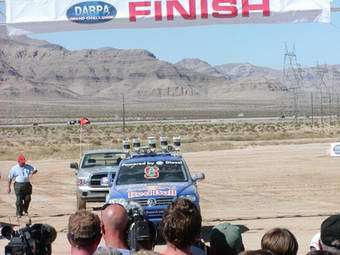Stanford takes first in off-road robot competition

Stanley, the Stanford Racing Team's entry in the Defense Advanced Research Projects Agency (DARPA) Grand Challenge, has finished first, earning the team a $2 million prize. The Oct. 8 off-road race pitted 23 autonomous vehicles against each other on a 132-mile desert course that began and ended in Primm, Nev.
Image: Stanley crosses the finish line in Primm, Nev., winning the 2005 DARPA Grand Challenge.
Only five vehicles made it through the course. With a finish time of 6:53, the Stanford Racing Team beat Carnegie Mellon's Red Team (7:04) and Red Team Too (7:14), The Gray Insurance Company's Gray Team (7:30) and Team TerraMax (12:51).
The Grand Challenge is an off-road robot competition devised by DARPA (Defense Advanced Research Projects Agency) to promote research in the area of autonomous vehicles. The challenge consists of building a robot capable of navigating 175 miles through desert terrain in less than 10 hours, with no human intervention.
The Stanford Racing Team started its work in July 2004. The present vehicle is fully functional and has logged dozens of miles in the Mojave desert.
The Stanford Vehicle (nicknamed "Stanley") is based on a stock, Diesel-powered Volkswagen Touareg R5, modified with full body skid plates and a reinforced front bumper. Stanley is actuated via a drive-by-wire system developed by Volkswagen of America's Electronic Research Lab.
All processing takes place on seven Pentium M computers, powered by a battery-backed, electronically-controlled power system. The vehicle incorporates measurements from GPS, a 6DOF inertial measurement unit, and wheel speed for pose estimation.
While the vehicle is in motion, the environment is perceived through four laser range finders, a radar system, a stereo camera pair, and a monocular vision system. All sensors acquire environment data at rates between 10 and 100 Hertz. Map and pose information are incorporated at 10 Hz, enabling Stanley to avoid collisions with obstacles in real-time while advancing along the 2005 DARPA Grand Challenge route.
Source: Stanford University




















